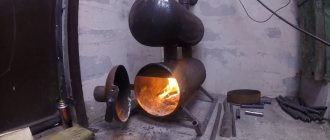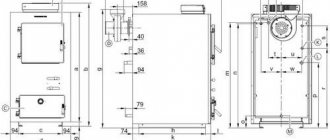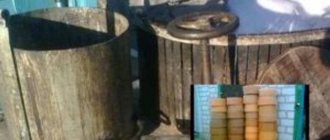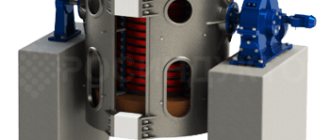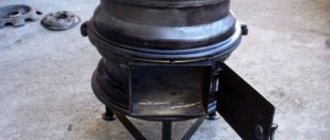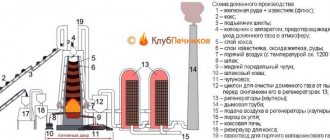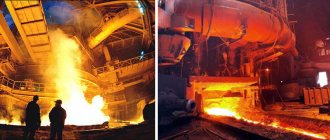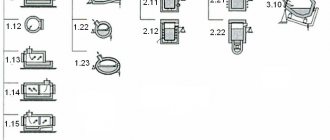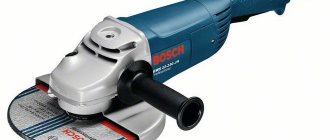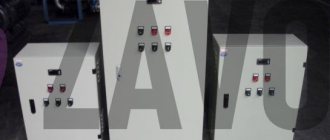Variation from discs
The metal variation can be created using an even simpler principle.
Car wheels are used for this. For a summer residence this is a very convenient and fast way. Especially when you don’t have a lot of time to create complex structures. Stages of creating a variation from rims: 1. Identical rims are selected. On one of them, the partition is sawed off (a grinder is used). It looks like this:
2. One disk is placed on the second, the partition of which is at the bottom. The function of the oven falls on it. The discs are fastened by welding.
3. The door is cut out. Handles-stand are mounted to the finished stove.
The stove can be heated a little by adding firewood.
Empty cylinder design
Widespread gasification has left us with a gift of memories of the past in the form of empty gas cylinders, which every owner of a country house can find. The cylindrical shape of this cylinder can be used to make homemade items.
Construction from an old cylinder
The upper part of the cylinder is cut off with a grinder; a cauldron will be installed on the end. Naturally, the idea will be realized if the dimensions of the cauldron and the diameter of the cylinder are compatible with each other. The total height of the stove should be three times greater than the planting depth of the cauldron. A hole is cut in the lower part of the cylinder wall for the firebox door. This door should be made from the freed piece of metal by welding hinges and a handle to it.
As a grate, you can use a bottom with drilled holes or install a separately made grate. The entire structure, if it does not have an ash pan, must be mounted on legs. This algorithm can be used when constructing a furnace from a piece of pipe of suitable diameter. The result will be a portable device with which it will be convenient to install a cauldron and cook various dishes in it.
Requirements for the grill
But before you cut and cook, you need to decide.
First of all, take a critical look at your grill: is it strong?
The cauldron stands precariously
Second: the width of the grill. The cauldron should fit the width of the grill.
Third: the depth of the grill. The cauldron is held securely if the ring fits almost under the handles. And in this position, there should be space under the cauldron for firewood or coals.
Some take a smaller ring and it turns out that the cauldron is wrapped in a ring in the lower half. But this is not reliable. Remember how well a wok collapses, the same will happen with a cauldron in such a stand.
Fourth: Grill legs. Considering the weight of the cauldron and the height of the center of gravity, it must be stable.
Making a stove for a cauldron from sheet steel
This is also one of the simplest options for making a stove, which will require:
- the cauldron itself to measure the diameter of the combustion chamber;
- welding, electrodes for it;
- steel sheets - the thicker they are, the better for the structure;
- hammer;
- corners for making handles and supports;
- electric drill;
- Bulgarian.
Note! Work should be done outdoors, near a source of electricity. At the same time, you must also follow safety rules
Step 1. Measure the circumference of the cauldron - according to the obtained size, further work will be carried out.
Step 2. Using a grinder, cut a rectangle from a sheet of steel, the length of which would be equal to the circumference of the cauldron. Make a hole in the rectangle.
Step 3. In the upper part of the future structure, mark and make several vertical slits so that the smoke can subsequently escape freely. Next, cut a rectangular hole at the bottom for loading firewood.
Step 4. Roll the sheet into a cylinder. To do this, use the appropriate form, wrap the steel around it and achieve extreme precision with a hammer, or (if possible) use special sheet bending equipment.
Step 5. Cut out supports and handles for the structure from the corners.
Step 6. Using welding, connect the sheet into a cylinder, then weld the bottom, handles and support elements to the structure. Although the latter can be screwed using ordinary bolts, having previously made holes in the steel.
Note! To protect the stove from corrosion, paint it with heat-resistant paint in several layers. That's it, you can put the cauldron in, load fuel and start a fire! Let's improve the design
Let's improve the design
For this purpose, we equip the stove with a chimney pipe, grate, ash pan and doors. The manufacturing procedure is the same as described above, but you will have to add a few points.
Step 1. Cut not only the firebox hole, but also another, smaller one located below, for the blower. At the top, cut a third hole for the chimney.
Step 2. Install a grate between the combustion and blower cutouts by welding supports - pieces of corners - inside the housing. To make a simple grate, you can use steel wire - fold the pieces of the required length and connect them together by welding. There is no need to attach the grate to the supports.
Step 3. Weld the chimney to the corresponding hole in the housing
It is important that the height of the chimney exceeds human height, otherwise smoke will get into the eyes
Step 4. Equip the chimney with a spark arrester - a tin can with numerous holes made in it.
Step 5. You can cut the doors from the same sheet steel, although you can purchase ready-made ones.
As a result, you will get this kind of stove for a cauldron with your own hands, which is convenient to clean from soot and where it is convenient to load fuel. Smoky gases will be discharged into the chimney, and draft adjustment will be carried out by the blower door. Although it is not so convenient to transport such a structure, since it is larger.
We use a scrap of metal barrel
A scrap of metal barrel and several pieces of fittings make a good stand for a cauldron with your own hands.
This simplest design has a number of specific advantages:
- There are absolutely no scarce materials.
- The open top design makes it easy to add firewood.
- The product, closed on the sides, ensures heat accumulation directly under the bottom of the cauldron, since the heat of the fire does not dissipate to the sides.
- Significant savings in firewood.
- High fire safety.
To make such a complex stand you will need:
- A metal barrel with a capacity of approximately 200 liters.
- Bulgarian.
- Any fittings with a diameter of min = 14 mm.
- Welding machine.
Manufacturing process:
- The barrel is cut in half or 1/3 of its upper part is cut off. The option is chosen completely arbitrarily.
- The cut off top will serve as the base of the structure, and it is installed directly on the fire.
- A pair of holes are cut or drilled in the lower part of this cut fragment of the barrel, which will ensure an optimal combustion mode for the fire.
- A triangle in the shape of the letter “A” is formed from segments of reinforcement. It is necessary to achieve such internal dimensions that the cauldron fits tightly into this kind of stand. The figure created from the reinforcement must be welded.
- If the proposed option from reinforcement seems too primitive, then the stand can be made in a rectangular shape or in the form of a circle with welded crossbars.
- An even better option will be if you select replacement hobs from an old stove.
Collapsible tripod made from simple materials
An excellent do-it-yourself tripod for a cauldron is made from a common mounting “din-rail”. The design is extremely lightweight and consists of a minimum of common parts.
An approximate version of the product is shown in the photo:
Need to purchase:
- Direct mounting rail. You will need 6 pieces of 50 cm each.
- The wire is soft - about 0.6 meters.
- Mounting nuts and screws included – 6 pairs. It is advisable to use wing nuts, as they will speed up the process of assembling and disassembling the device.
- Metal chain for hanging a vessel.
- Any metal hook.
Device assembly process:
- Three sections of future tripod legs are folded into a tripod pyramid.
- At the junction points, holes for fasteners are drilled, and the pyramid is fastened with wire. The result was a miniature tripod. Its height is approximately 0.5 meters.
- Then the lower parts of the legs of the future tripod are attached and holes are drilled for the mounting bolts.
- Next, the lower parts of the rack legs must be joined to the upper ones and secured with bolts and nuts.
- The assembled complete structure is checked for strength and a chain with a hook is fixed in its upper part.
- The work is done. Do-it-yourself tripod for a cauldron - completely made.
- Using similar technology, you can make a more complex fire structure for several culinary devices. An approximate view of such a product is shown in the top photo on the right. Naturally, some additional materials will be required, since the “din rail” is clearly not suitable for the crossbar.
A popular stand option is made from car rims.
Car rim stand
An excellent stable stand for a cauldron can be made from the most ordinary car wheels. To do this you need:
- Place the disk so that the side with the mounting holes is at the top.
- 2/3 of the height of the cauldron is measured, and a circle is drawn with chalk.
- Next, the diameter of the drawn line is calculated, and a hole is cut in the disk, the diameter of which is equal to the calculations obtained.
- The stable stand is ready.
- If you weld the legs to the bottom of such a converted disk, you will get a good campfire variation of a tripod. But it is better to use such a tripod only in the countryside, since the weight of the entire welded structure will be very impressive.
- In addition, it should be noted that a pair of such disks makes a very compact and decent stove for a cauldron.
Here is a short overview of the designs of stands and tripods for cauldrons.
Furnace design for working with a cauldron
This design is not very complicated. It resembles a barbecue, but round. The cauldron is always used for cooking, only with an open flame. Therefore, this option is taken into account in the design of the stove.
The optimal design for working with a cauldron would be a special system equipped with removable legs. A sufficiently large area allows you to install dishes and cook right in your garden. Transport the stove to any place thanks to its collapsible design. With the onset of cold weather, she can be taken home.
The stove on which the cauldron is placed resembles a metal cylinder. It is supported by massive legs. The bottom is made at the bottom, the top part is missing. If a special desire arises, it can be equipped with a chimney, but this is not at all necessary. In such furnaces, special cutouts are made at the top of the cylinder. They play the role of a smoke exhaust.
When food is cooked, there is an economical consumption of heat, since the flame is well protected from strong winds. In this design, the dishes are completely closed from the wind, therefore, they warm up much faster.
Design Features
The design of the stand directly depends on the cauldron itself, which can have a flat or round bottom and vary in size and weight. This explains the division of support into the following types:
- A traditional tripod-tagan, which is a circle into which a cauldron is lowered, and three legs extending from the circle at a slight angle. This design is simple, stable and reliable, and the stands themselves can be monolithic or collapsible. The latter is convenient to take on a hike.
- Podkazannik – a square design with a round hole on top, used on the grill.
- A miniature stand used to stabilize a round cauldron on a gas stove or table.
- Suspended structure - can be made in the form of three metal guides connected to each other at the top. A hook is mounted at the top, on which the cauldron is suspended over the fire. This tripod is suitable for using different sized cookware.
A correctly placed tripod makes cooking convenient, and it is important to follow the rules for using the product:
- It is necessary to consider the possibility of access to fire and coal in order to regulate the heating of the container.
- The weight of a filled cauldron is quite large. If a fire is lit on damp or frozen soil, then under the influence of temperature its density may change, the legs will go into the ground and the tripod will change its inclination. A design without a suspension system can even topple the boiler due to the shifted center of gravity. In order to avoid troubles, you need to place pieces of board under the legs in advance or weld small plates to them.
- You should not place the legs of the product in a fire, since heating the metal can cause its deformation, and touching a hot part will lead to burns.
A tripod is a simple design common among outdoor enthusiasts. The size of such stands ranges from 60 to 120 cm, and the choice of a specific model directly depends on the goals of the future owner. Let's take a closer look at several types of products.
- Small - a tripod for a cauldron with a height of about 70 cm can be easily and quickly installed above the fire. The hook clings to a chain, thanks to this design it is easy to adjust the height for different types of dishes, as well as control the cooking temperature. The small stand is especially popular among tourists because it is easy to carry.
- Large - such a tripod can be more than a meter high. The main advantage of the design is that you can hang a cauldron of any diameter on it. The dishes should have handles in the form of brackets, with which they can be secured to the support. This durable device is made of steel. The disadvantage is its impressive dimensions, which do not allow transporting the stand to the picnic site. Such models are usually used on personal plots.
- Round is a convenient option for preparing complex dishes. This stand looks like a short cylinder on three legs; a cauldron is placed on top of it. There is a hole in the wall for lighting a fire under the container. This is a convenient option that quickly heats and cooks food using only a small amount of wood or coal. With all its convenience, this is a three-dimensional design: the diameter of the pipe for a cauldron with a volume of 10–12 liters will be no less than 40 cm.
- Folding is the most convenient and easiest design for transportation and storage. When folded, it takes up very little space and is easy to disassemble and assemble. The tripod is assembled from hollow tubes, they are quite reliable, but at the same time easy to carry. The legs usually consist of two parts inserted into each other. This solution ensures compactness; the product can even fit into a bag. Folding tripods often have a hook and chain that allows you to control the height of the utensil. The permissible weight of a full cauldron on such a stand cannot exceed 10 kg.
- With two hooks - the simplest design with a small crossbar on top, which allows you not only to cook food, but also to heat the kettle at the same time.
The last few models are suitable for preparing food while hiking because they take up little space and are light in weight.
Large Folding With two hooks Small Round
Pipe cauldron stove
The thickness of the metal firebox wall is an important factor that determines the service life of the product. Thick sheet metal will last significantly longer than thin sheet metal.
The powerful wall perfectly accumulates thermal energy and then transfers it to the cauldron with food. Metal heat generators are similar in their properties to cast iron bodies. Metal has only one drawback, compared to cast iron, and that is susceptibility to corrosion. Therefore, it is best to coat the metal surface with a protective compound.
Mobile stoves are needed by people who often travel outdoors. These are hunters, fishermen, fishermen, gas workers, oil workers, geologists, tourists, summer residents (at the beginning of the season it is brought to the country house, and in the fall it is taken away). Of course, there is not a wide variety of materials for mobile options. The list of mobile ovens is limited to metal models.
The main advantage of such a stove will be mobility and durability. Mobile stoves differ from stationary ones in the thickness of their walls. If the system is stationary, the wall thickness is 3 mm, and the mobile structure is made of steel 2 mm thick. There are mobile installations made of powerful hardware.
Manufacturing materials
It is important to know what material the support under the cauldron is made of, since dishes come in different weights, and if you purchase an aluminum device for it, the device may not support the weight. When choosing, you should focus on the weight of the container. You also need to take into account that due to heating, low-quality material can quickly become unusable.
Materials for making a stand for a cauldron on a grill can be:
- Cast iron is the most versatile raw material. It is considered almost eternal. The cast iron stand is not affected by strong heat and the heaviness of the cookware. The structure itself will weigh a lot, so it is used only for stationary use. But the cast iron device will perfectly transfer heat to the cauldron, which will make the dish especially tasty.
- Steel - the weight of such a stand will be less than cast iron. However, in all its other characteristics it is in no way inferior. If you evaluate the material in terms of weight, quality and reliability, a stand for a cauldron made of steel will be the best option.
- Aluminum - a device made from it is convenient to take with you on trips to nature. It is lightweight, but not very durable - under the weight of the dishes, the legs and ring quickly become deformed. Another disadvantage is that it does not retain heat well.
When choosing, you need to focus on your own needs and regularity of use.
Types of stoves for cauldrons
Depending on the material of manufacture:
- metal stoves (factory-made and home-made);
- stationary brick structures.
Brick stoves vary depending on the method of installing the cauldron:
- in classical designs, the cauldron is placed almost completely in a brick recess;
- in modified versions, the cauldron is installed on a specially mounted burner.
Ovens are also divided according to the method of cooking:
- specialized devices only for using the cauldron;
- universal (multifunctional) devices in which food can be cooked using a cauldron and other devices (for example, a grill for frying meat or a portable hot smoker).
The choice of one type of design or another depends on personal preferences.
Features of brick stoves
There are two types of schemes for a brick oven - classic and multifunctional or universal.
A classic oven looks like this:
- steel plate for fixing the cauldron;
- metal corners for securing the plate;
- firebox with door;
- blower;
- smoke channels and chimney;
- external walls that frame the entire structure to achieve a better thermal insulation effect.
If we are talking about creating a universal oven, its design has a number of differences:
- plates for fixing cooking utensils;
- for each device (for example, for a cauldron, a grill for frying meat and a smokehouse) its own firebox is created, because it is necessary to achieve maximum efficiency from each surface;
- in order to combine all the created surfaces into one chimney, it is necessary to erect an arch above them, in which the outlet to the chimney will be made.
What is
Oriental dishes come in various sizes and shapes. Traditionally it is made in the form of a hemisphere. The stand is needed to maintain the cauldron in the correct position. The product helps prevent the boiler from tipping over and promotes uniform heating of the surface. Thanks to it, dishes turn out more juicy and tasty.
Previously, ordinary bricks were used as support, but such a design is unreliable and unaesthetic. To regularly cook food over an open fire, you should take care of purchasing a stand for a cauldron.
The design of the device depends on its type. Most models consist of two elements:
- metal ring;
- legs - their number may vary.
The device for supporting the container must be installed carefully - at an angle so that its legs have a uniform height. The stability of the structure is also important. The cauldron is placed in a ring so that it is in the center and rises above the fire by about a third of the total height of the dish.
Product made from wheel rims
Aesthetics are not always important in stove design. There are cases when the bet is made only on the functionality of the device. An example of folk art is a device consisting of two wheels. The disc septum is usually shifted to one side. The lower disk is positioned so that its partition is as low as possible. At the top disk it is completely removed.
The discs are aligned coaxially and connected by welding. The lower partition plays the role of a grate. The cavity of the two disks is the firebox. All that remains is to cut a hole in the side for the door, weld the handles and legs, and you can use the homemade device.
Simple and clear design
How to make a stove from gas cylinders?
A fireplace for heating a cauldron made from a gas cylinder is a portable device that can be installed in any convenient place and can even be used in camping conditions. To make it you will need the following materials:
- gas cylinder;
- fittings;
- grate;
- Door hinges;
- other related materials.
In the process of assembling a stove from a cylinder, the following consumables will be used:
- cutting discs for grinders;
- grinding wheels for angle grinders;
- sandpaper;
- drill;
- welding electrodes.
Minimum set of required tools:
- welding machine;
- Bulgarian;
- electric drill;
- hammer;
- measuring instruments (tape measure or ruler);
- other related tools.
The gas cylinder is installed on its base. At a distance of 60-70 cm from its lower part, a mark is placed indicating the location of the cut. A circular line is drawn through the mark
It is important that it is drawn strictly parallel to the surface on which the cylinder is installed. Along this line, using a grinder and a cutting wheel, the balloon wall is cut
The top sawn part is removed.
Vertical triangular cuts are made in the cutting edge of the cylinder. Their number and depth are determined by the individual design of the future furnace. These cutouts are necessary to maintain stable draft after installing the cauldron on the stove. The absence of draft holes will create a vacuum inside the oven, causing the flame to go out. A rectangle is marked on the side wall of the cylinder. Sawing is performed along the contour line of the rectangle. The resulting hole will serve as the entrance part of the future firebox, and the cut piece will serve as the stove door.
A rectangular section of the cylinder wall is welded to its original place using hinge hinges. On the side of the combustion hole opposite the hinges, a piece of metal is welded from the inside.
Its location should be such that it prevents the door from opening into the cylinder and at the same time does not interfere with loading firewood into the firebox. For convenience, a handle is welded to the surface of the door, which can be made from fittings. In order for the door to close securely, a movable valve is equipped on its edge adjacent to the cylinder body.
Below the main hole, a hole for the blower is cut out. Its width should correspond to the width of the firebox opening, and its height should not exceed 10 cm. The rectangle of metal obtained after the cutout is used to construct a door, which helps regulate the amount of oxygen entering the firebox.
A grate is installed between the combustion door and the blower - a grate that prevents fuel material from entering the ash collector. To arrange a grate inside a round furnace, you can use reinforcing rods, the length of which will vary depending on the round shape of the internal space of the balloon furnace.
To install a grate, it is better to use reinforcement with a diameter of at least 20 mm. This is explained by the presence of high temperatures inside the oven at the time of its heating. Reinforcement with a smaller diameter can quickly burn out.
At a distance of 15-20 cm from the upper edge of the stove, U-shaped handles are welded, with the help of which this stove can be transported. These handles are made from reinforcement with a diameter of 12 mm. To ensure the stability of the balloon furnace, special spacers can be welded to its lower part. The number of spacers is determined individually, depending on the operating conditions and the size of the cauldron that will be installed on the hearth.
A stove for a cauldron, made with your own hands from a cylinder, is a multifunctional device. It can be installed in the country house, and with some modifications it can be used as a barbecue on which you can fry meat. A balloon stove can be used as a heating stove installed in a garage or some other utility room.
Tripod
Making your own tripod is rational and easy. For the simplest option, you will need metal and a welding machine. More complex products have folding elements in their design. Of course, such tripods are the most convenient to use, but the manufacturing process is much more complicated than conventional ones. If you plan to install a cauldron in the country, you can choose a one-piece design. It is simple and has excellent stability.
Required materials and tools
What you will need to make a tripod:
- fittings;
- welding machine;
- electrodes;
- welding mask;
- welding mittens or gloves
When choosing the material for making a tripod, it is preferable to choose fittings. It is very stable and can withstand high temperatures well. The required amount of reinforcement is calculated only when the height of the finished structure is determined. You will need 3 identical cuts. The larger the cauldron, the higher the tripod should be. The most common tripod option has a height of 50 to 90 cm.
For example, for a cauldron with a diameter of 30 cm, the recommended height of the tripod is 120 cm from the ground (standing on three legs). It may be smaller, it all depends on your wishes, but it is the specified height of the tripod that will allow you to light a fire under the cauldron without any problems.
You will also need two sets of three jumpers of the same size. The first is necessary to connect the top of the tripod, which has a triangular shape. Despite the fact that the cauldron itself is round, if the dimensions of the pieces of reinforcement for a triangular structure are correctly calculated, its position will be stable. In this case, the cauldron is installed inside. The length of the reinforcement on one side of the stand (cauldron with a diameter of 30 cm) will be 21 cm. The jumpers are welded in the center of the tripod, for example, at a height of 60 cm. They provide it with stability.
Step-by-step manufacturing instructions
Making a tripod is very simple. If you wish, you can make your own drawings or use a ready-made one. Having made the necessary sections of reinforcement, they are welded. For convenience, it is recommended to carry out work with an assistant who will monitor the even arrangement of the parts and hold them.
After completing the welding work, it is necessary to clean the seams with a grinder. This is done for the beauty and finished look of the product. When cleaning seams, you can use the following tools:
- Bulgarian;
- cleaning circle.
Connecting the rings and chainConnecting the tripod legs
We clamp the stand so that the hooks do not fall out
Attach the hook
Adjust the height Done
Advantages and disadvantages
A homemade tripod for a fire has the following advantages:
- Easy to make and use.
- Cheap manufacturing.
- The ability to make a product yourself, even a beginner can handle it.
In addition to the advantages, this design has the following disadvantages:
- Cheap look.
- Difficulty in transportation.
- Possibility of using a cauldron of a certain size.
Where to use
The tripod can be used wherever lighting a fire is permitted. However, it is not recommended to install it on a grill. This design is not reliable and may fall. People nearby may suffer burns and injuries. It is best used for cooking when installed in the country, on trips out of town, outdoors or in the forest. For safety, the tripod is placed on the ground and hammered with improvised means (hammer, axe, stone). It will be stable and allow leisure time to pass safely.
Making a metal stove from a cylinder
As noted earlier, the easiest option for creating a stove is a tripod. We will not consider it, since in this case everything is extremely clear.
And we’ll talk about a portable metal stove, which is advisable in cases where people do not live at the dacha permanently, but, for example, only on weekends. An excellent option for this is an unused, but still usable gas cylinder with a volume of 50 liters. At one time, such cylinders were extremely popular in the village, but not so long ago they were replaced by electric stoves and natural gas. In addition to the cylinder itself, prepare a grinder for work.
The sequence of actions is as follows.
Step 1. Empty the gas cylinder - open the tap and wait at least a week.
Step 2. Mark the cut line. For our design we will need the part of the cylinder with the bottom. Step back about 25 centimeters from the bottom and draw a straight line.
Step 3. Make a neat cut with a grinder, then try on the cauldron. As noted, it should go in about two-thirds of the way. If the cauldron is too large, then make several 5-centimeter cuts on top in increments of about 15 centimeters.
Step 4. Cut a window 20 centimeters from the bottom for loading fuel. The width of the window should be large so that no difficulties arise in the future.
Step 5. Try it on again to make sure that the cauldron fits tightly enough.
Step 6. Next, you should calcine the stove for the cauldron with your own hands. To this end, remove the cauldron, load the firewood and heat until the odors completely disappear.
That's it, the design is ready, and you spent a minimum of materials and tools to make it!
Sequence of work
We make a step-by-step oven for a cauldron with our own hands. Using a grinder, a partition is cut out in one disk, with holes made for mounting bolts. It is better to cut along the border of the holes, this will reduce the labor intensity of the work.
We find places for spot welding that holds the partition and rim. At this point the metal is cut straight to the rim. The operation must be done carefully so as not to damage it.
Cutting the partition should be done at a distance of 1.5–2 cm from the location of the weld spot. The cut off partition can be easily removed. Just pry it out with a flat screwdriver.
It is very important to preserve the remaining part of the partition directly at the welding point. It forms a gap between the stove and the cauldron
As a result, strong draft occurs and the cauldron is evenly heated.
Then welding work is carried out. The prepared disks are placed on top of each other, and the disk with the partition cut out should be at the top.
The entire fastening partition of the lower disk will play the role of the bottom of the stove. Welding of evenly installed disks is performed along the entire circumference. Then the door is made. In well-welded discs, a vertical cut is made corresponding to the dimensions of the door. You need to leave a small metal strip at the bottom. You will get a kind of threshold that does not allow the coals to fall out of the oven.
Bolts and nuts are inserted into the cut made. These parts will become loops. Bolts are welded to one side of the cut and nuts to the other. Then a hole is cut for the door. A long bolt is welded. It will act as a strong handle. The ends of the opening and the sharp edges of the door are cleaned of burrs. To do this, you can use an ordinary file or an electric grinding disc.
The next step is to make handles for transporting the stove. The wire is taken, inserted into a vice, where it is bent into the desired shape. To work with such wire you will not need much effort. Right angles can be easily made with a regular hammer.
Nuts are placed on the handles. They are welded to the walls on opposite sides. To make it easier to work with such handles, you need to bend the small tails at a right angle. You will get a reliable stop that prevents the handle from touching the stove body.
The legs are welded to the bottom. The length of such supports should not exceed 30 centimeters. A hole is welded into the disk through which the wheel hub passed. To do this, you can use any piece of metal of a suitable configuration. The stove is loaded with wood. It needs to be well calcined. During this time, the paint will all burn out. Then it will need to be repainted with good heat-resistant paint.
To create such a design, an experienced craftsman will need 2-3 hours. The appearance will have a compact appearance. Thanks to its light weight, it is easy to transport in a car. Such dimensions fit freely in the trunk.
Doors are used to adjust the draft. Its strength changes when opening or, conversely, closing the door. It is better to use wood briquettes as fuel.
Based on materials: https://topkvadrat.ru/interior/article/kak-sdelat-pech-dlya-kazana-iz-kolesnyh-diskov-svo-38043
What not to do
In the photo you see the design that we found on the Internet when we were collecting information.
We don't recommend it.
The cauldron stands high and therefore not securely. And someday it will turn over.
If you are afraid of the complexity of making a ring, then you can make a square. But this is only suitable for cauldrons with four handles and a thicker rod will be required.
As you can see, the stand for the cauldron is a simple thing and you can make it yourself. We are glad that it turned out and plans for a brick oven under the cauldron have moved somewhere into the future. Delicious dishes on fire!
Source
Sheet steel furnaces
You can truly show your creativity by making a structure from sheet steel. A metal stove will last longer the thicker the material is selected. However, this type of work requires the ability to operate a welding machine.
The size of the rectangular sheet, especially its width, depends on the size of the cauldron. We measure the cauldron around the circumference in the part where it will be held in the stove body, and cut off a sheet of iron with a width equal to the readings taken. The height of this sheet will correspond to the height of the oven. Despite the fact that the distance from the core to the bottom of the cauldron will be adjusted when installing the grate, the height of the entire structure must be selected based on convenience and common sense.
An assistant will be needed to perform further manipulations. The sheet of metal must be rolled up to form a cylinder with a height equal to the height of the sheet. The structure is welded at the seam and is completed with handles, a grate, a stand and a chimney.
Brick version
All the different designs of furnaces can be divided into two main types.
- The simplest stove for a brick cauldron is represented by a firebox, in the upper part of which the cauldron is attached. The system is complicated only by the presence of a chimney. However, such a structure leads to the fact that the flame acts directed towards a certain area of the vessel, and the walls heat up unevenly.
- The second option involves complex flows of hot air, from which heating occurs, and the flame itself is somewhat removed from the surface of the cauldron.
Both methods of building a furnace are accompanied by the construction of a foundation. But in this case, due to the fact that the simplified brick structure has a relatively small mass, there is no need to build a full-fledged foundation. A reinforced concrete slab is also suitable. If this is not possible, then the slab is poured independently.
System for cauldrons of different sizes
A pillow is installed in a pit 30 cm deep. In order for the slab to be strong, when pouring it is necessary to reinforce the solution with any suitable available means (rods, stacks, sheets). One of the important conditions for pouring the foundation is the creation of a horizontal layer in the form of a flat plane.
The design for a brick cauldron with your own hands in a simplified form is made in 13 rows according to the established pattern. It is advisable to use time-tested projects, especially for novice craftsmen.
Order for a small stove
The first row is laid out as a continuous base. In rows 2 and 3 there is an ash pan with a door. Its purpose is to collect ash and provide air flow. The 4th row is covered with fireclay bricks, and a grate is mounted in the center, on which the firewood will be burned.
The whole difficulty of laying out 5-11 rows lies in the fact that the firebox is laid out in a cylindrical shape. To do this, the brick is processed with a grinder. This is a rather labor-intensive process, but you should not try to avoid it. The fact is that some craftsmen lay out the circle with untreated brick, adding more mortar in the seams. But the requirements for masonry in places where high temperatures occur is to minimize seams, especially in the case of fireclay bricks. A larger amount of solution will cause the masonry to rupture.
In the 12th row there is a hole for the chimney. Let us immediately note that in such structures the chimney has an initially horizontal direction. Then it must be turned exactly at an angle of 90°. After the overlap, a slab with a cutout for a cauldron is installed in row 13. If it is not possible to purchase such a stove, then having sheet metal, a grinder, a file and some imagination will allow you to get out of the situation.
A more professional approach is implemented in a scheme with lowering channels. Here the walls of the cauldron are heated by moving streams of hot air.
Furnace with sink channels
Despite the complexity of the idea, building such a stove for a cauldron with your own hands is also not difficult.
Varieties
Such devices differ in design. The main varieties are:
- A tagan in the form of a tripod is a metal circle from which three legs extend at a slight angle. The cauldron is placed in a circle.
- A stand with four legs is a convenient device that can be either cast or collapsible. The second option is used less frequently.
- A barbecue holder is a square-shaped device with a circle in the center into which the boiler is inserted.
- Small stands for a cauldron, designed for the table and stove. A miniature tripod is usually installed on the latter. The model placed on the table is made of wood so as not to damage the surface of the furniture.
- Pendants with a hook on which a cauldron is hung.
Each model is characterized by certain features. They must be taken into account when choosing how to install the device.
Tagan (tripod)
This is the simplest design. The tripod is very convenient for people who often travel outdoors. The device is installed in such a way that the legs rest firmly on the ground, and a fire is lit in the central part, where the ring is located. Afterwards, a cauldron is placed in the circle so that the flame does not touch the bottom of the dish.
A similar stand for a cauldron can be monolithic or prefabricated, which is very convenient for a picnic. Factory tripods are decorated with simple patterns. Tagans are produced both for the fire and for the barbecue. Production methods are also different. Products can be welded, forged, or bent from a finished sheet of metal.
Four-legged design
Such a device is completely similar in appearance to a tagan, but has four legs instead of three. Some users prefer this design, claiming that it is more reliable and stable. You can buy a cast stand or a collapsible one. The second one is convenient to take with you on picnics.
Grill holder
This base is easy to use. It will come in handy if you have to cook food not only over an open fire, but also in a cauldron. Serves as an excellent replacement for brick structures. The device for the cauldron on the grill is made in the form of a square base, in which a hole is provided for installing a piece of cookware. You can also purchase an option equipped with a grill for preparing shish kebab or barbecue.
